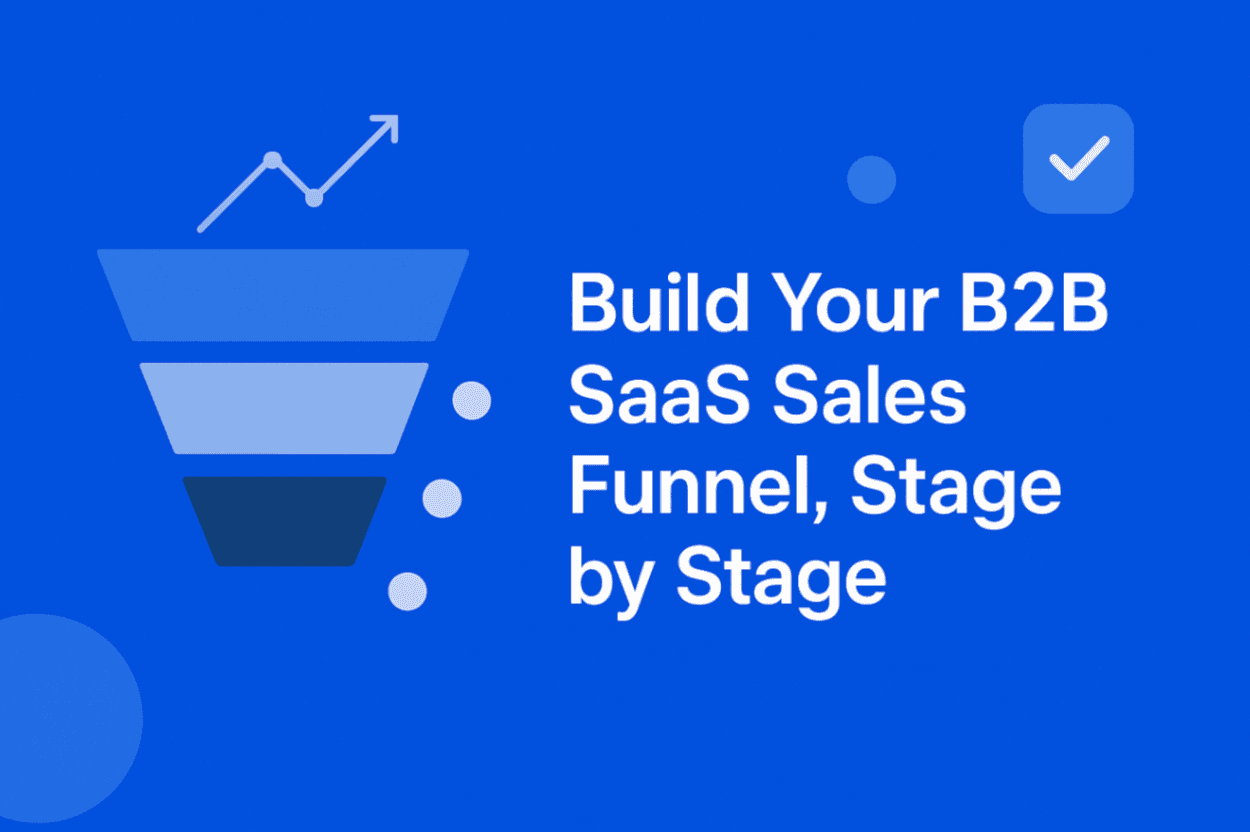
TL;DR
|
Remember sitting through a product demo where the rep spent 20 minutes explaining buttons you’d never use?
In 2025, buyers don’t have the patience for that. They want to get hands-on with your product immediately: no sign-ups, no scheduling, no awkward small talk. Just click, explore, and see if it solves their problem.
That’s exactly what interactive demos deliver. They let prospects experience your product in a polished, guided, and self-paced way, the closest thing to “try before you buy” without the setup headaches.
We’ve picked the best interactive demonstration software of 2025 to help you do just that. And if you stick around till the end, we’ll show you how to automate the whole thing.
What Is an Interactive Demo?
An interactive demo is basically a clickable, guided simulation of your product, the kind that prospects can explore freely without having to sign up, download anything, or risk breaking your live environment. In crux, it’s a sandboxed version of your product built to feel real while staying totally safe.
Here’s a quick example of an interactive demo in action.
Most are created with no-code or low-code tools that record your product’s interface and turn it into a lightweight, browser-based walkthrough. The good ones let you:
Keep it safe – no production data, everything runs in an isolated environment.
Drop people right into the action – skip boring logins and start at the “aha” moment.
Guide without smothering – use hotspots, tooltips, and branching paths so users can explore at their own pace.
See what’s working – built-in analytics track where people click, how far they get, and where they drop off.
If you think about it, interactive demos sit right in the sweet spot between:
Videos – great for control, but you just sit and watch.
Free trials – super immersive, but heavy onboarding and potential for chaos.
Live demos – personal and flexible, but a nightmare to scale across time zones.
As our founder Robin puts it best, “If a picture is worth a thousand words, then an interactive demo is worth a million” , and once you try one, you’ll see why.
When to Pull Out an Interactive Demo?
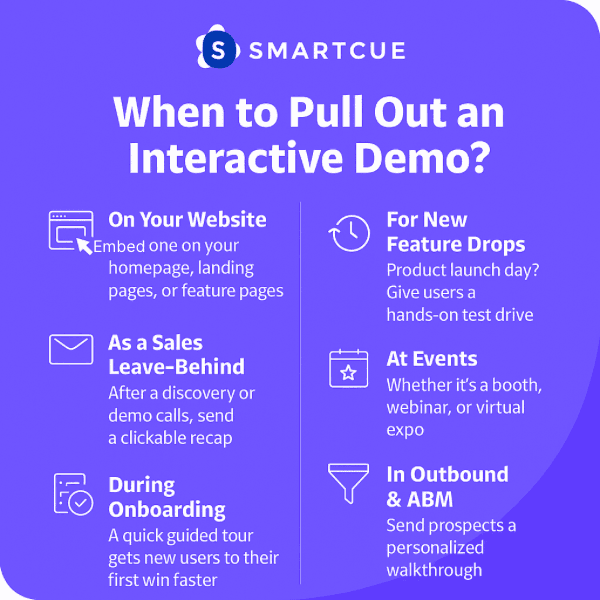
Interactive demos aren’t just for show-and-tell. They work across the entire buyer journey, from curious click to contract signed, and they do it without slowing anyone down.
Here’s where they earn their keep:
On Your Website: Create interactive demo and embed on your homepage, landing pages, or feature pages. Let people click around before they even think about booking a call.
For New Feature Drops: Product launch day? Give users a hands-on test drive without handing over real access or booking training.
As a Sales Leave-Behind: After a discovery or demo call, send a clickable recap instead of a “let’s follow up next week” email. Keeps the deal warm without extra meetings.
During Onboarding: Skip the PDF manuals. A quick guided tour gets new users to their first win faster.
At Events: Whether it’s a booth, webinar, or virtual expo, let attendees try your product in seconds. No logins, no fumbling with accounts.
In Outbound & ABM: Send prospects a personalized walkthrough built for their exact use case. It’s the opposite of a one-size-fits-all landing page.
Wherever your buyer is, an interactive demo puts the product in their hands, minus the sales pitch and the scheduling headache.
What Are The 10 Best Interactive Demo Tools for 2025?
We know the struggle; some interactive product demo software tempt you with a free trial but hide the good stuff behind a learning curve. Others have brilliant embeddable features but fall flat when you try to reuse them.
So, to save you the headache, here’s our shortlist of 10 favorites, from the top all-rounders to specialized picks worth checking out.
1. SmartCue (G2 Rated 4.8/5)
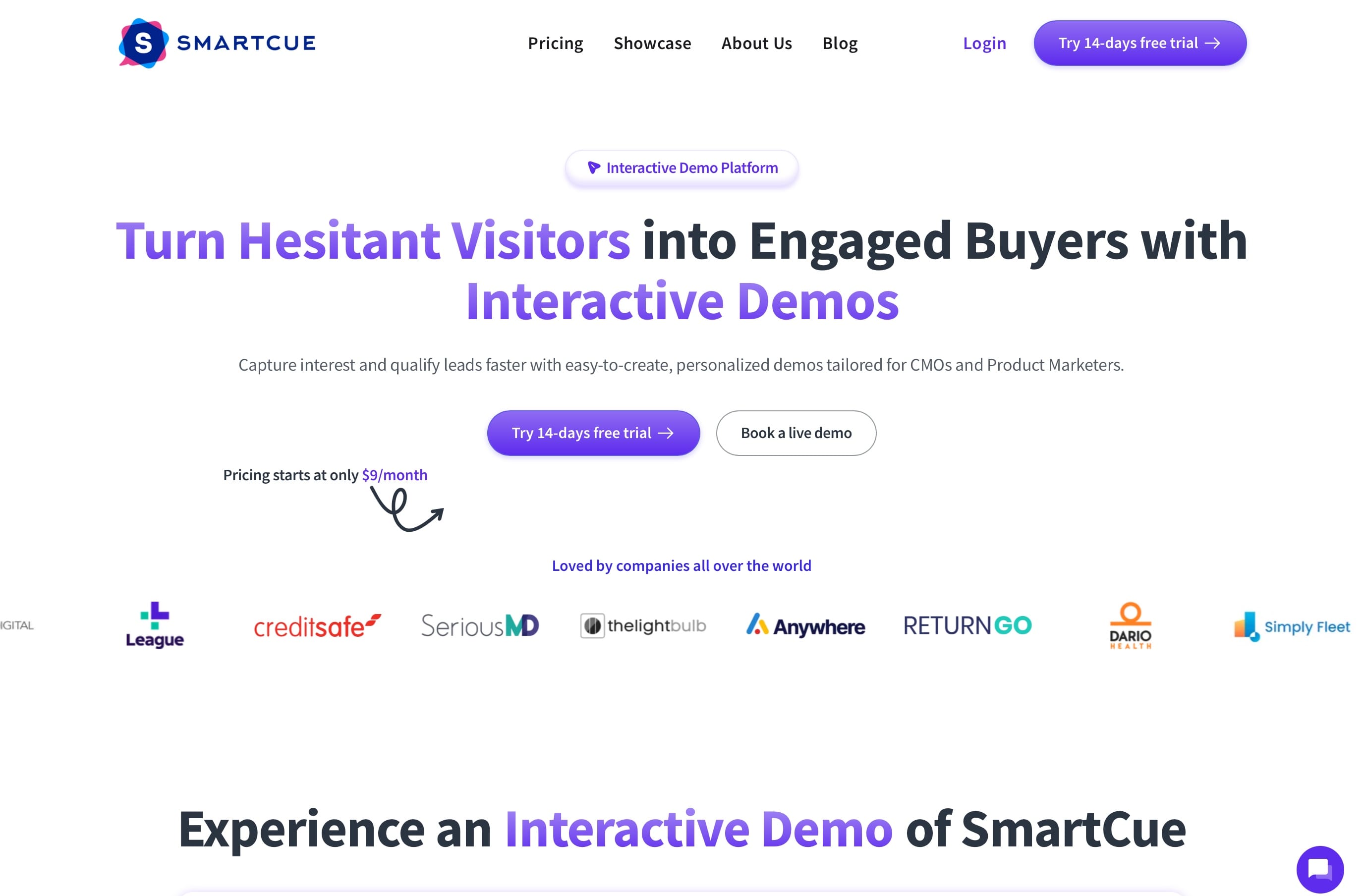
SmartCue makes it ridiculously easy to turn your product into a guided, clickable experience without touching a single line of code. In minutes, you can create branded, reusable demos that live anywhere your prospects are, from landing pages to sales decks.
Best For: Mid-market and enterprise GTM teams that need scalable, self-serve demos with built-in guidance and analytics, perfect for shortening sales cycles without overloading sales engineers or devs.
Pricing: Starts at just $9/month.
What Makes This Tool Stand Out?
No-code capture – Record flows with a Chrome extension, publish instantly.
Custom branding – Keep demos on-brand with your colors, logo, and messaging.
Embed anywhere – Share via link, website, email, or sales deck.
Branching flows – Let buyers choose their own journey.
Analytics built-in – See where users click, drop off, and convert.
Role-based access – Control who sees what, from public to private demos.
What Real Users Are Saying
"Initially, I procured SmartCue to enhance our product demos, aiming to provide a more immersive and interactive experience for our prospects. What I didn't expect was the sheer adaptability of the tool! Beyond its core functionality… SmartCue has truly outperformed my expectations."
Tony G., Sr. Product Marketing Specialist, Enterprise (G2 Review)
2. Navattic (G2 Rated 4.8/5)
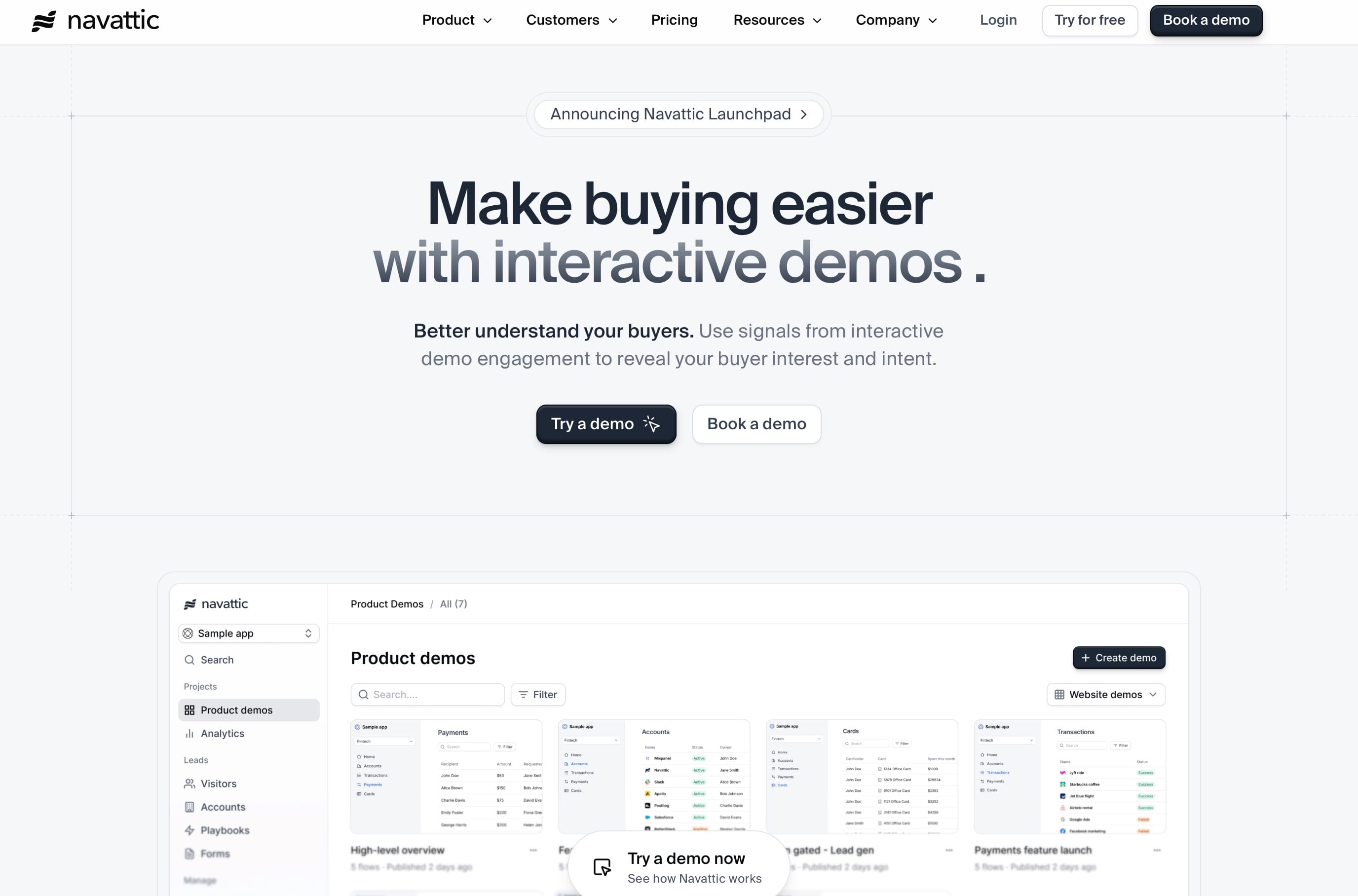
Navattic turns your product into a self-guided, clickable demo without relying on engineering resources. You can capture your UI, add tooltips, and embed the experience anywhere prospects are likely to engage. It’s designed to give buyers a realistic feel for the product without giving them direct access, making them useful for top-of-funnel education and lead capture.
Best For: SaaS marketing and sales teams that want quick, no-code product tours for prospects, especially for short, focused demos rather than long, complex walkthroughs.
Pricing: Free starter tier, with paid plans ranging from $600–$1,200/month and custom pricing for enterprise.
What Makes This Tool Stand Out?
HTML/CSS capture via Chrome extension to create interactive software demos that mimic the live product
Dynamic checklists for guided flows
Personalized share links tied to specific accounts or firmographic data
Built-in analytics and real-time alerts for engagement tracking
Integrations with HubSpot, Salesforce, G2, Segment, Marketo, and GA
Free starter tier available, with paid plans offering advanced features
What Real Users Are Saying
“Really great way to help potential customers understand the product, easy to share, easy to make. Easy to use and start, and the customer success folks are amazing. They really seem to want to listen to customers and make the product better.”
- Taylor K. (G2 Review)
3. Storylane (G2 Rated 4.8/5)
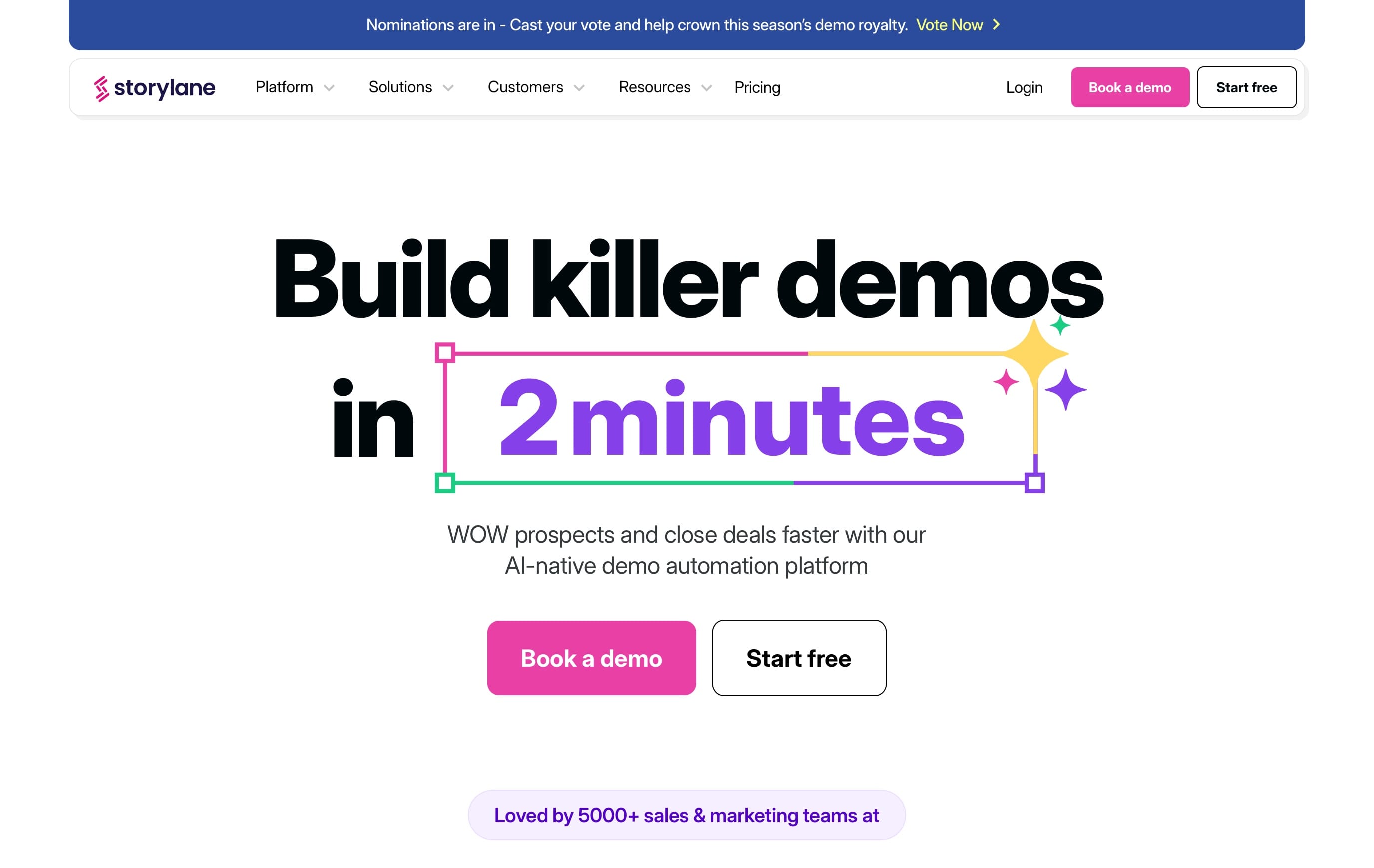
Storylane lets teams capture product flows and turn them into guided demos in minutes with a Chrome extension and a no-code editor. You can layer in tooltips, highlights, and overlays, then embed or share the demo so prospects can explore at their own pace. Great for producing quick, self-serve tours, though more complex, dynamic product experiences may need extra customization work.
Best For: Marketing and sales teams that want to spin up simple, visually guided demos for lead generation, onboarding, or quick feature walkthroughs.
Pricing: Free plan for basic guided demos, with paid tiers from $40/month (billed annually) up to $1,200/month for advanced HTML demos, Buyer Hub access, and deeper customization. Custom pricing available for enterprise plans.
What Makes This Tool Stand Out?
Chrome extension capture for instant product flow recording
No-code editor to add tooltips, highlights, and overlays
Embeddable demos for websites, emails, or shareable links
Collaboration tools for building demos as a team
Engagement analytics to track clicks, completions, and drop-offs
What Real Users Are Saying
“Storylane is a user-friendly platform for creating interactive product demos without needing code. It’s quick to set up, offers good customization options, and integrates well with other tools. Great for sales enablement and onboarding, though advanced users might wish for deeper analytics and more complex branching logic. Overall, a solid choice for making polished, shareable demos fast.”
- Carlos P (G2 Review)
4. Walnut (G2 Rated 4.7/5)
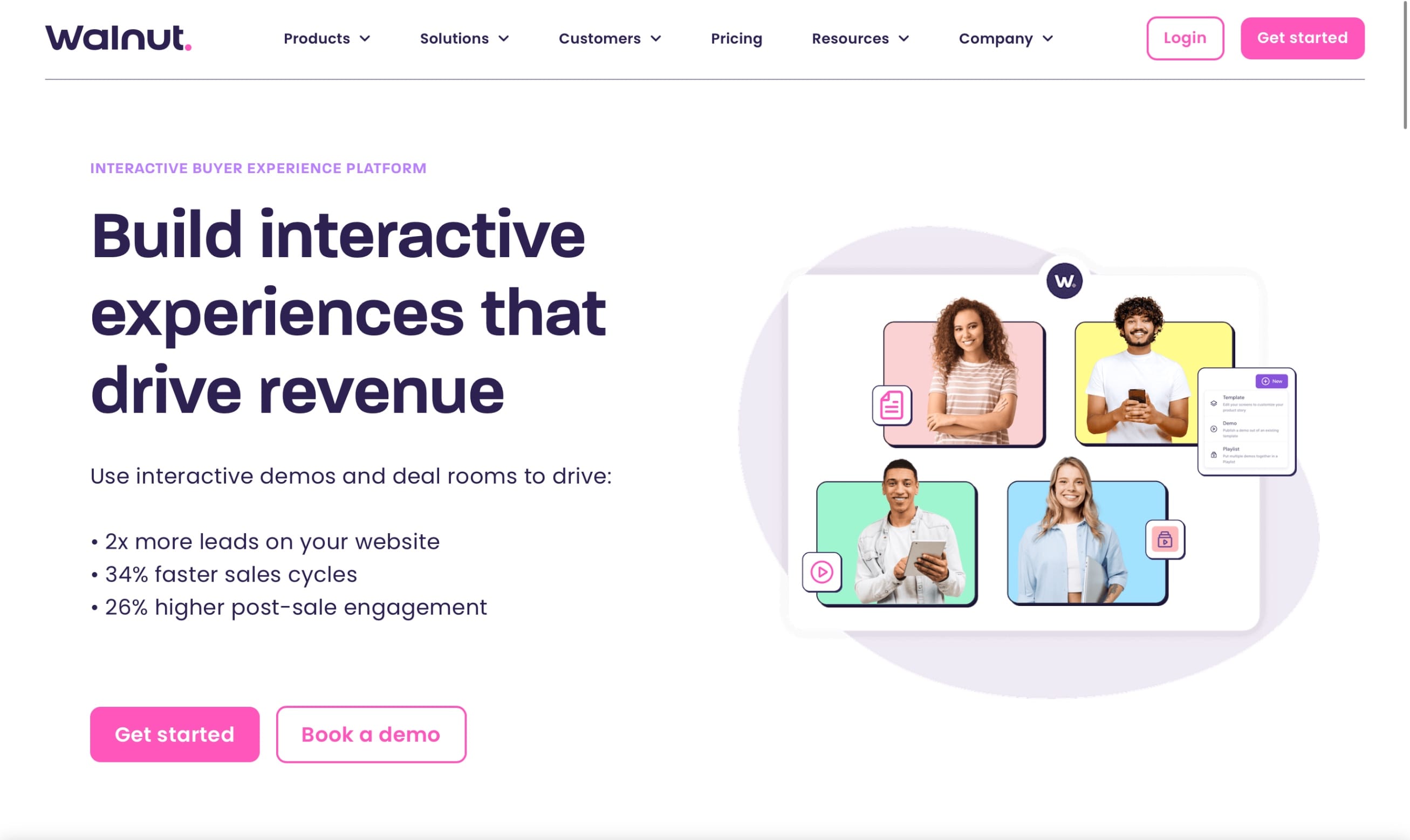
Walnut focuses on building fully personalized, interactive demos that can be tailored for different audiences, from first-time leads to complex enterprise deals. Sales teams can replicate their product UI and adjust each flow for a specific buyer persona. The customization is powerful, but setup can take more time, and pricing is geared toward larger teams.
Best For: Enterprise sales teams managing complex products that need tailored demos for multiple decision-makers.
Pricing: Paid plans start around $750/month, with higher tiers adding analytics, customization, and extra seats. Enterprise pricing available for large-scale rollouts.
What Makes This Tool Stand Out?
Fully customizable flows that mirror your real UI
Personalization for specific buyer personas or segments
Real-time collaboration for demo creation
Performance analytics to compare demo variations
What Real Users Are Saying
“Using Walnut, it's so easy to create clickable demos to show during calls or to send to customers afterwards. Within a minute you can add a customer's logo to personalize the experience. Still some kinks in actually creating the demos, organizing them, and customizing - it took me a while to do the initial creation. Also it doesn't save automatically.”
- Aviva R (G2 Review)
5. Arcade (G2 Rated 4.8/5)
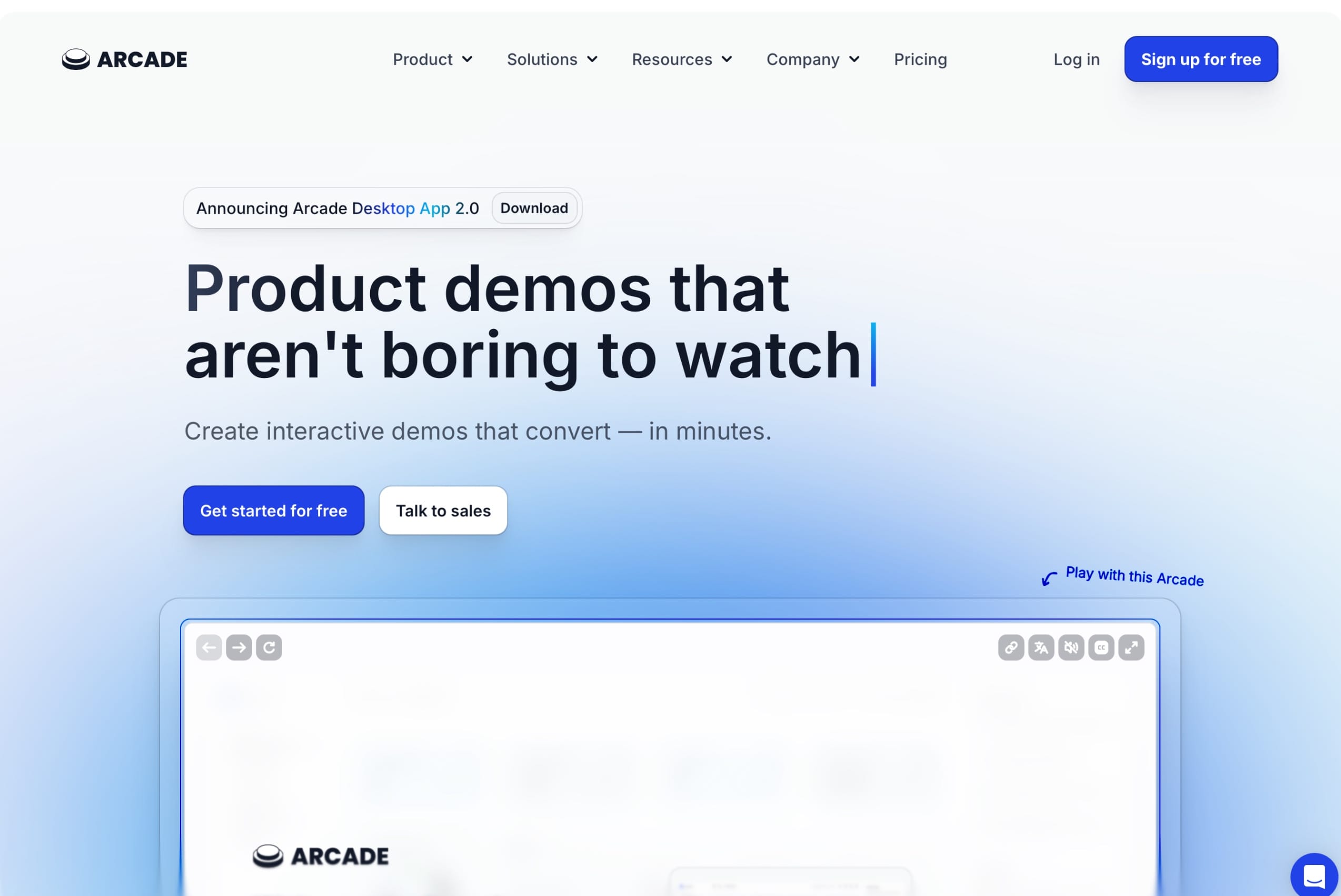
Arcade makes it simple for GTM and product marketing teams to turn screen recordings into quick, clickable demos or GIFs using its Chrome extension. Its snackable, social-friendly style is great for launches or onboarding snippets, but less suited to in-depth product tours.
Best For: Product marketing and GTM teams creating short, shareable demos for launches, social media, or how-to content.
Pricing: Free plan available; paid plans start at $32/month, with higher tiers adding white-labeling, advanced editing, and team collaboration. Enterprise options available.
What Makes This Tool Stand Out?
Screen recording to clickable demos or GIFs in minutes
Custom branding with your themes and colors
Flexible sharing via links, embeds, or exports
Editing tools for chapters, music, voiceovers, and blurring sensitive info
What Real Users Are Saying
“Arcade provides our business an interactive experience of our product, which can be difficult to explain without showing. The platform is intuitive, making it easy for us to build demos quickly with the chrome extension.”
- Juliette F. (G2 Review)
6. Reprise (G2 Rated 4.6/5)
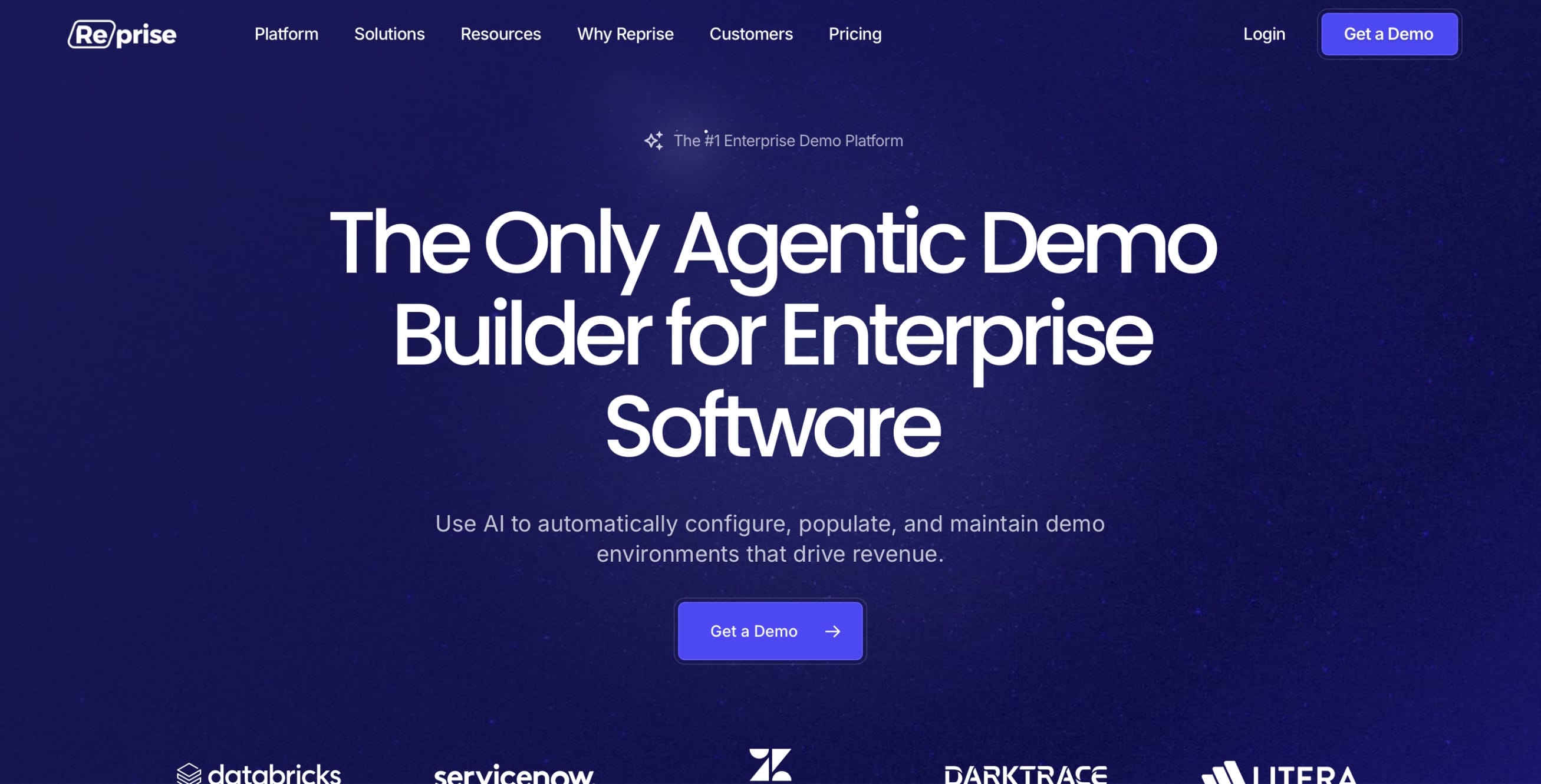
Reprise gives enterprise teams the choice between guided, replayable demos or live, sandboxed experiences, both designed to avoid exposing live data or environments. It’s best for high-stakes sales cycles where security and accuracy matter most.
Best For: Enterprise SaaS companies with complex sales cycles and strict compliance needs.
Pricing: Custom pricing based on team size, usage, and security requirements.
What Makes This Tool Stand Out?
Two modes: Replay (guided) and Reveal (live sandbox)
Secure staging environments mirroring your product
Permission controls for internal or external access
Templates for scalable demo creation
Custom branding for buyer-specific decks
SOC 2-compliant for data security
What Real Users Are Saying
“Reprise allows us to scale our demos and verticalise in mostly easy UI friendly way without needing to create multiple environments.“
- Anastasia S (G2 Review)
7. Consensus (G2 Rated 4.8/5)
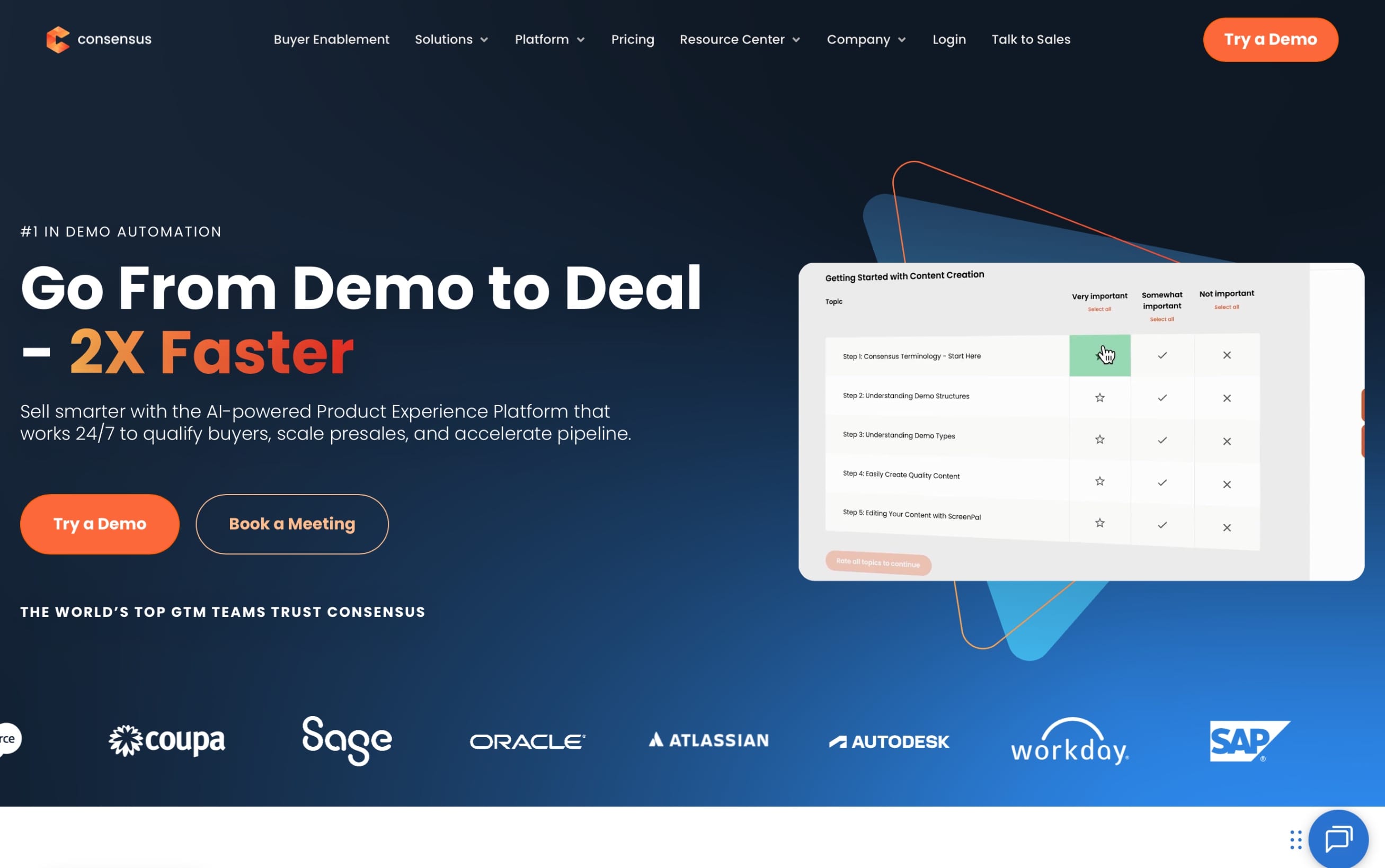
Consensus automates demo delivery with interactive video demos that adapt based on what viewers click or watch. It’s designed for scaling personalized buyer education without overloading reps.
Best For: Mid-to-large sales orgs wanting to automate product education and reduce live demo time.
Pricing: Custom pricing tailored to team size and demo volume.
What Makes This Tool Stand Out?
Interactive demo videos with branching logic
Automated follow-ups based on viewer behavior
CRM and marketing automation integrations
Pre-recorded demos for consistent messaging
Buyer intent signals to identify hot leads
Engagement analytics to measure impact
What Real Users Are Saying
“The self-led customer demonstrations. As opposed to sending a Loom video, you can curate a specific video demonstration for your customer and track the engagement of your customers. When prospecting or working with a larger/more transactional book of business, this is a great tool for concise value adds in your outbound messaging and follow ups.“
- Tom L (G2 Review)
8. Demostack (G2 Rated 4.7/5)
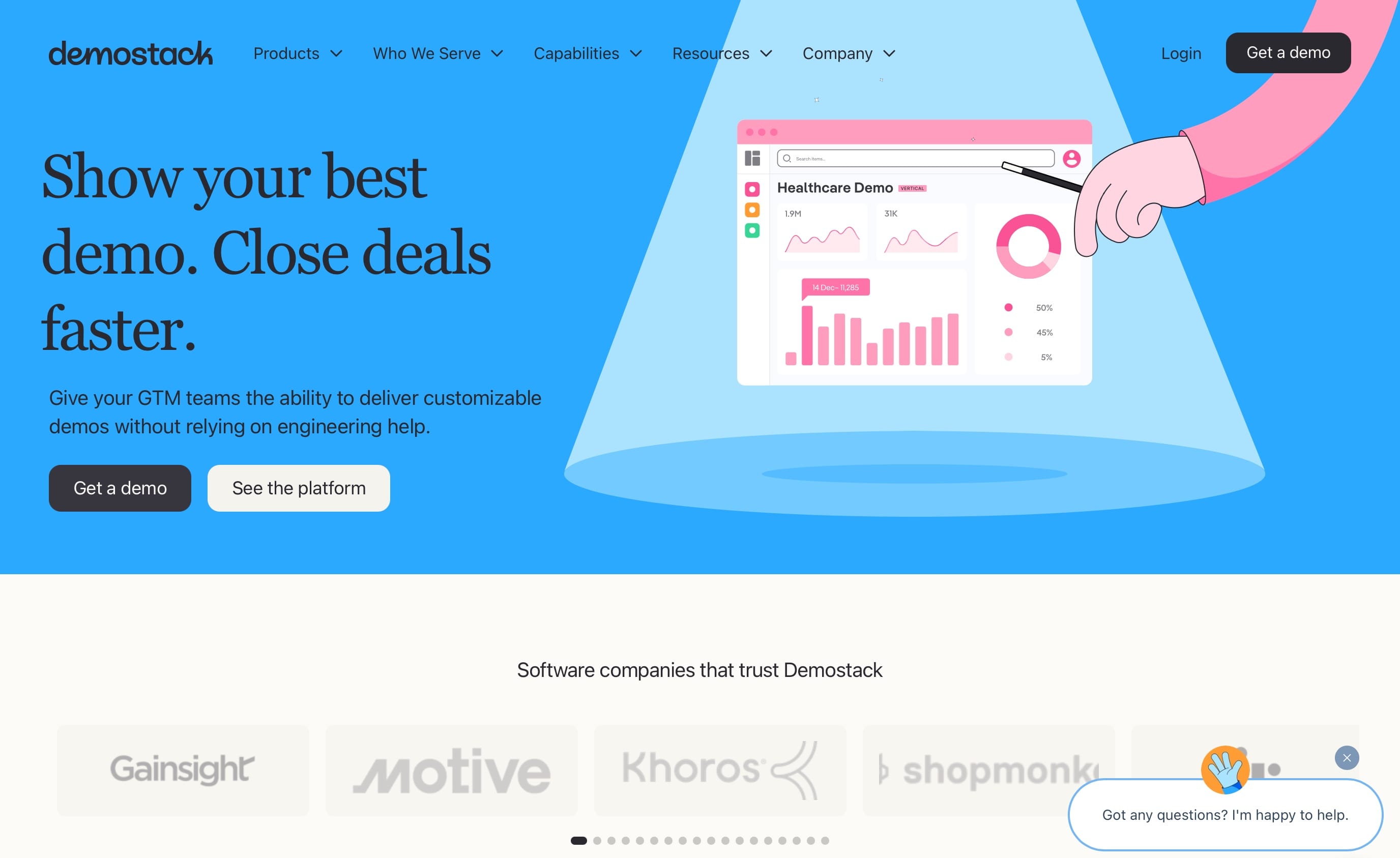
Demostack creates a fully interactive clone of your product, letting you demo without live environment risks. It works well for complex setups but is best suited to teams with technical support in place.
Best For: Growth and enterprise teams delivering live, personalized demos that need full product replication.
Pricing: Custom pricing based on environment complexity and user count.
What Makes This Tool Stand Out?
Interactive product clone, no live environment needed
Personalized flows for industries or personas
Offline mode for on-site demos
Drag-and-drop editor for updates
Sandbox mode masking real data
Role-based access controls
Demo analytics for real-time engagement
What Real Users Are Saying
“The ability to share product sandboxes that send real-time alerts when buyers interact with them keeps the conversation going even after the initial call ends.”
- Declan T (G2 Review)
9. Tourial (G2 Rated 4.7/5)
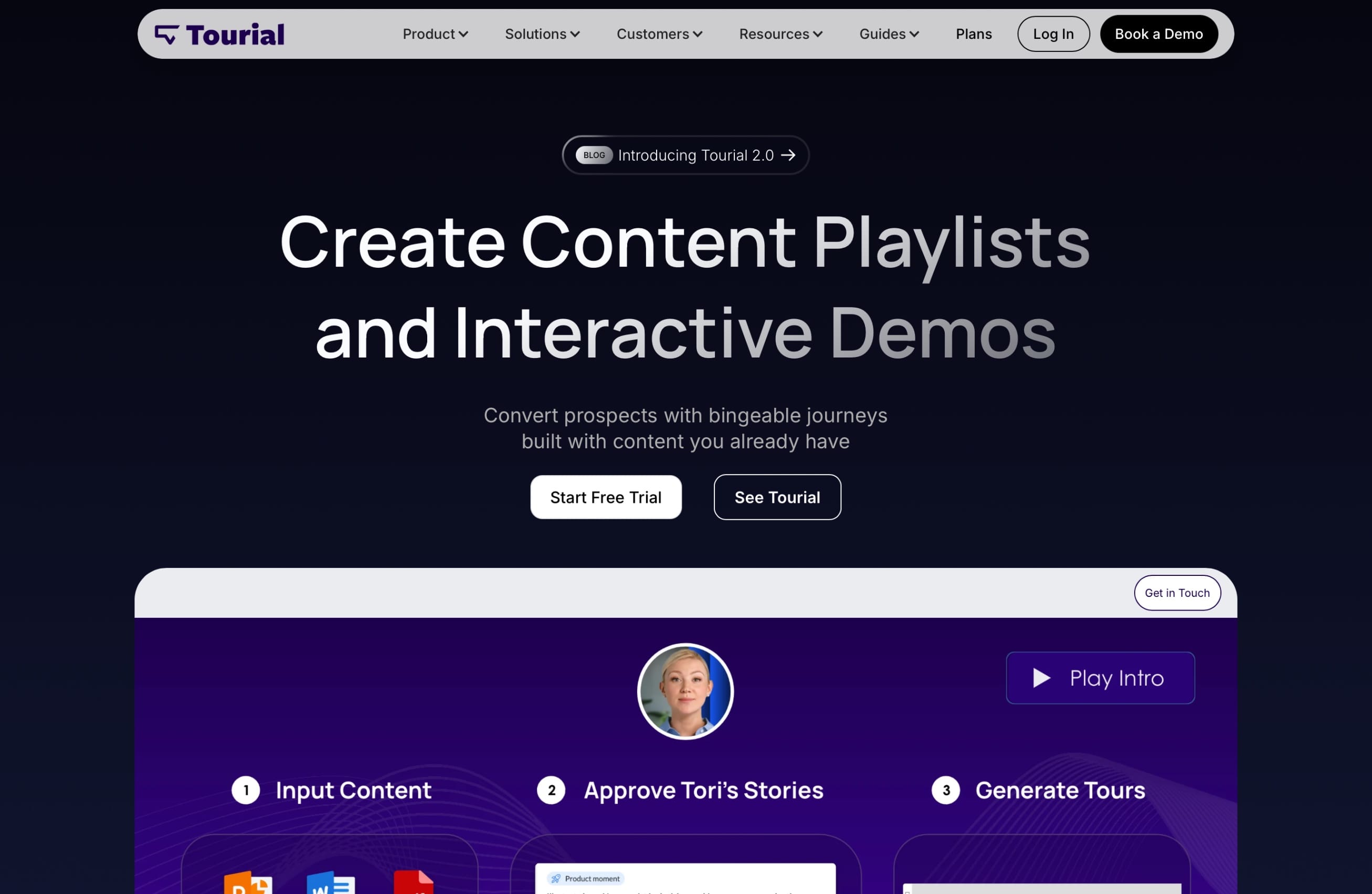
Tourial embeds instant, interactive product tours directly into your site for lead capture and top-of-funnel engagement. It’s intuitive, but more basic when it comes to deep personalization.
Best For: Marketing teams wanting to convert site visitors into leads with quick product previews.
Pricing: Custom pricing based on traffic and team size.
What Makes This Tool Stand Out?
No-code builder for click-through tours
Built-in lead capture forms
Interactive hotspots, overlays, and CTAs
Mobile-optimized playback
Simple analytics for completions and drop-offs
Embeddable demos for sites, ads, or emails
What Real Users Are Saying
“Tourial is easy to use. The product has an exemplary user interface and works very smoothly. But the best part about Tourial is the team. From the first call, we were impressed with the team's dedication and how they helped us reach our goals. They work with us closely, come up with great ideas and are open to any feedback we have.”
- Daan D (G2 Review)
10. Supademo (G2 Rated 4.9/5)
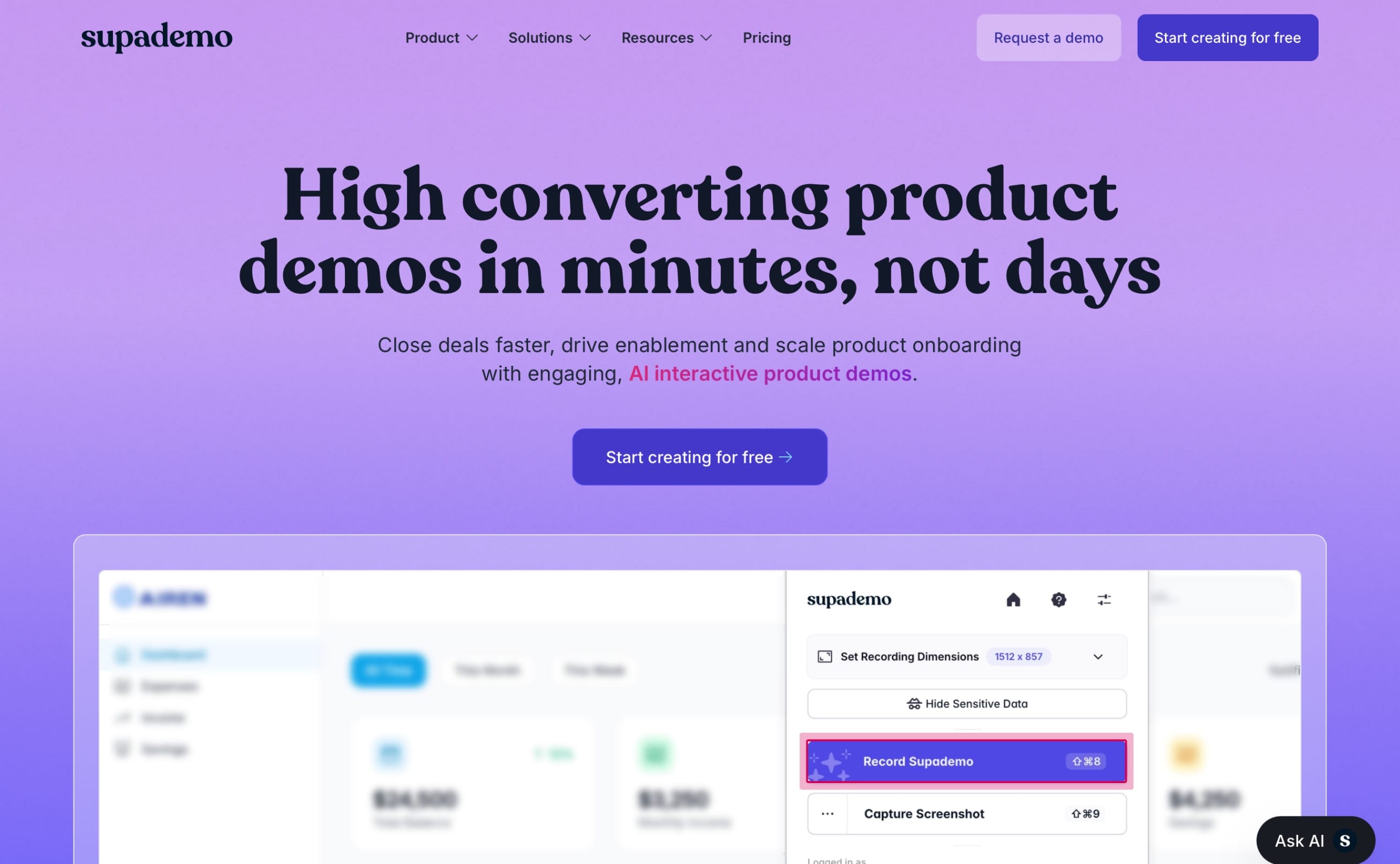
Supademo uses AI to turn screen recordings into polished, interactive demos. It’s fast and lightweight, making it ideal for simple, step-by-step flows.
Best For: Support, success, and product marketing teams creating quick, reusable walkthroughs for onboarding and education.
Pricing: Free plan available; paid tiers from $27 to $350/creator/month, with enterprise pricing for larger teams.
What Makes This Tool Stand Out?
AI-assisted demo creation from screen recordings
Auto-generated steps, tooltips, and annotations
Embeds for onboarding docs and landing pages
Multi-language support for global reach
Lightweight format for fast loading
Custom branding and styling
Analytics to track engagement
What Real Users Are Saying
“The ability to add and remove hotspots and the customization in the focused area makes it fitting for a variety of use cases. Inability to change the font size and not being able to import screens and hotspots from another supademo.”
How to Choose and Use Your Interactive Demo Tool Like a Pro?
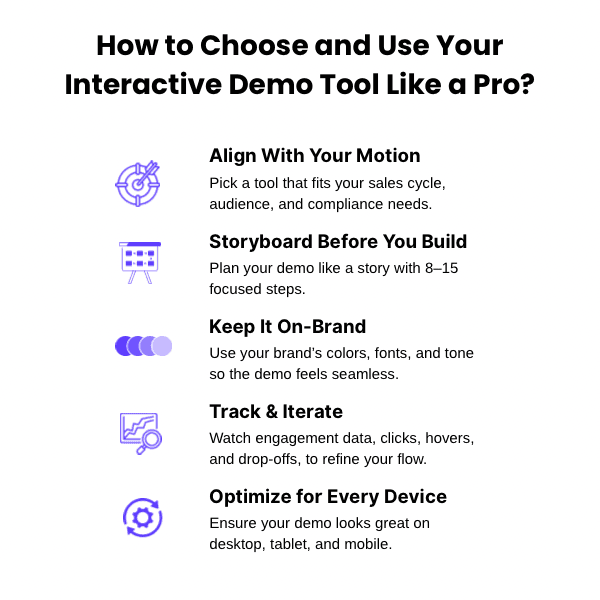
There’s no one-size-fits-all tool for interactive demos. The right platform depends on your GTM motion, product complexity, and how your buyers prefer to engage. But no matter which you choose, the real difference comes from how you use it.
Align the tool with your motion: Consider your sales cycle, audience size, and compliance needs. A complex enterprise sale may call for advanced customization and security, while a fast-moving SMB launch might benefit from speed and simplicity.
Storyboard before you build: Treat your demo like a story. Map out the journey in advance, keep it within 8–15 purposeful steps, and highlight moments where the product’s value becomes immediately clear.
Keep it on-brand: A demo that feels disconnected from your product risks losing trust. Use your brand’s colors, fonts, tone, and even microcopy so the experience feels seamless.
Track and iterate: Engagement data is your guide. Watch where prospects click, linger, or drop off, and then adjust to keep them moving forward.
Optimize for every device: Whether it’s embedded on your site or sent via email, make sure your demo is responsive and looks great on desktop, tablet, and mobile.
Nail these steps, and your interactive demo becomes more than just a preview; it becomes a scalable, always-on asset that moves deals forward.
Still Running Every Demo Live? Here’s a Smarter Way.
When your sales engineers spend hours each week on repetitive live demos, they lose valuable time for technical deep dives, tailored solutions, and strategic deal support. The reality is, not every prospect needs a high-touch walkthrough right away, but most still want to “see the product” before moving forward.
SmartCue has helped hundreds of sales teams change that. Instead of forcing businesses to waste hours being on every call, they can create interactive software demo once and reuse them endlessly.
Here’s how:
Layer contextual guidance with tooltips, hotspots, and callouts that mimic a real conversation.
Add branching paths so prospects can follow the workflows most relevant to them.
Version and update demos instantly; no re-recording or re-coding required when your product changes.
Track engagement at a granular level to see which flows or features are getting attention before you even speak to the prospect.
The result? Your sales engineers spend their time where they’re most valuable, while prospects still get an immersive, confidence-building look at your product.
Free up your sales engineers without losing the personal touch; book a demo today.
How Can SmartCue Help You Turn Interest into Sales?
You can launch your product demo in minutes with these four simple steps:
Step 1: Sign Up and Log In
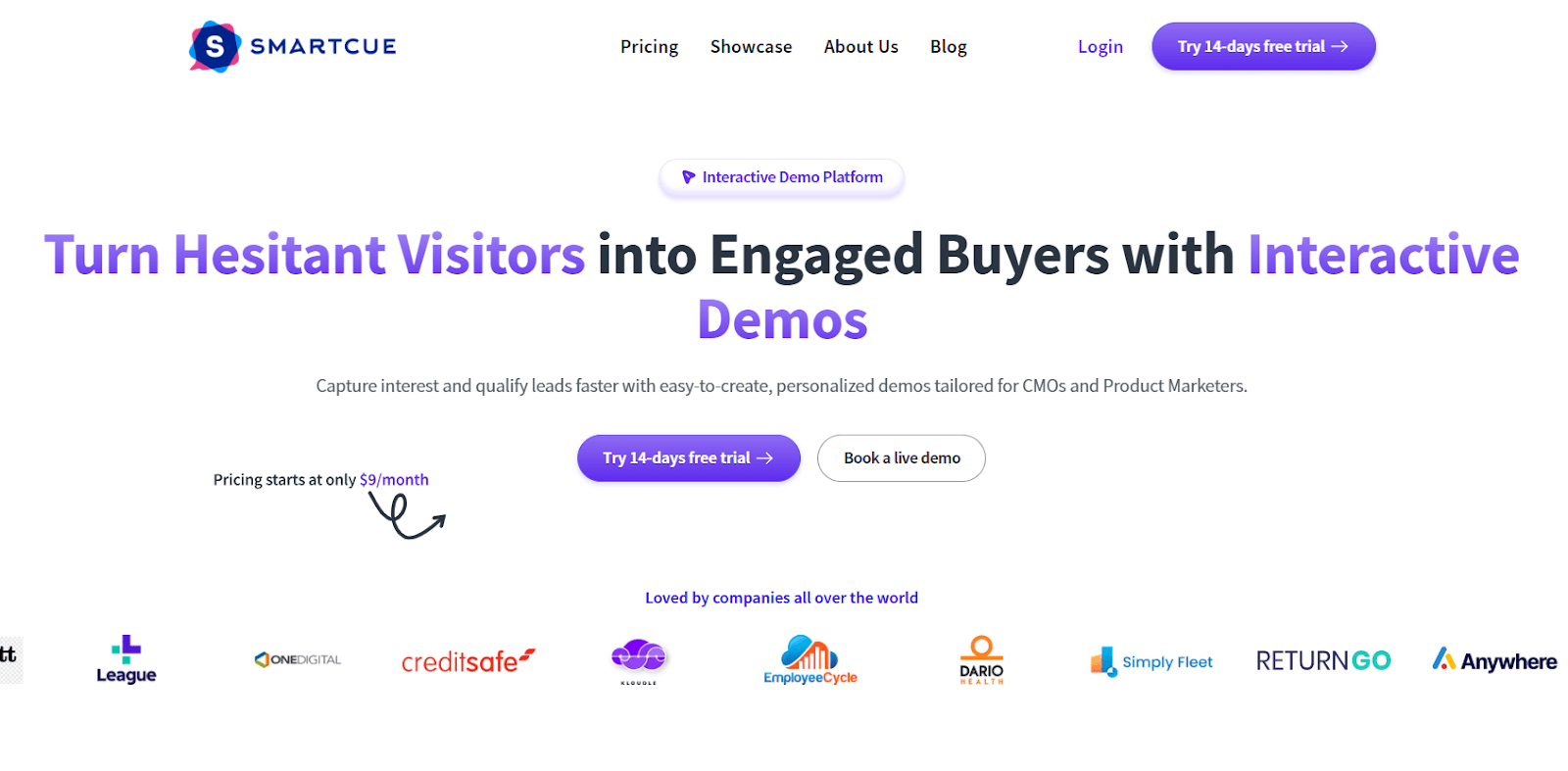
Start with a free trial to explore SmartCue’s clean, intuitive dashboard.
Step 2: Create Your Showcase
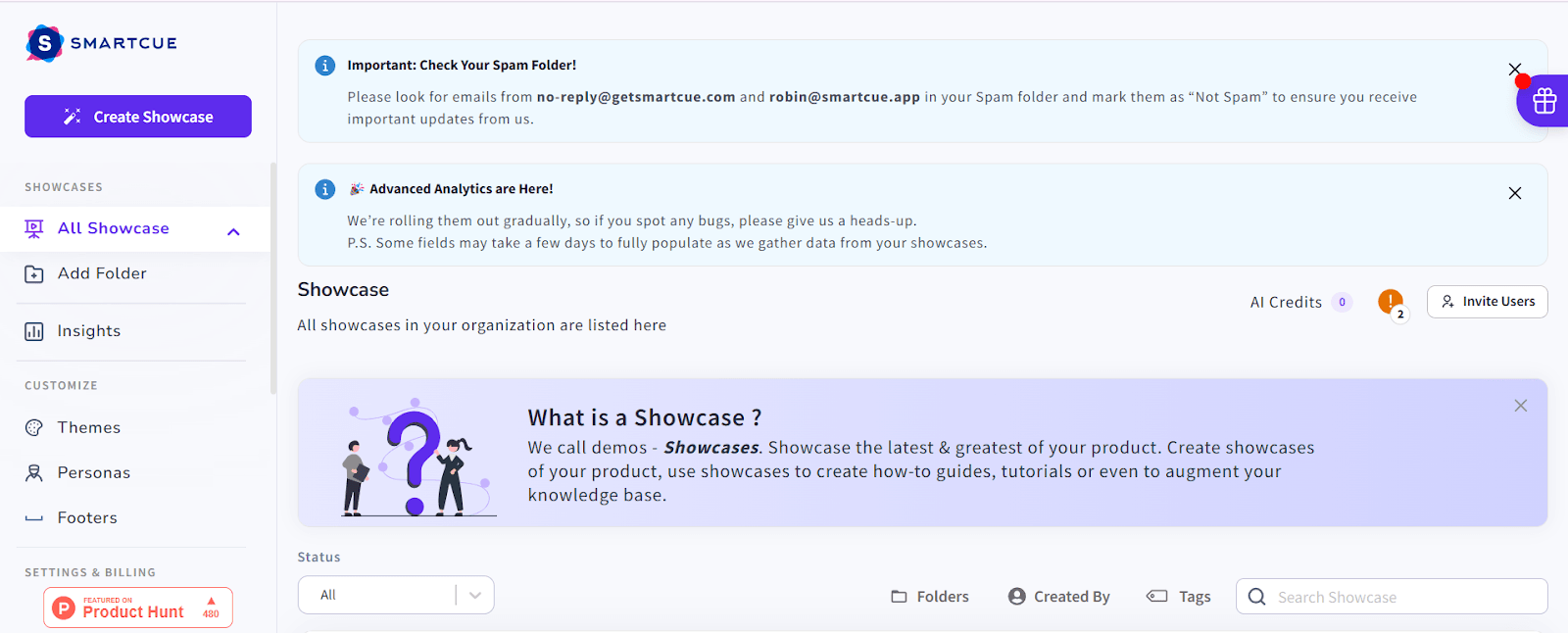
Set up a new showcase by either uploading your content manually or using the SmartCue browser extension for quick capture.
Step 3: Build and Enhance
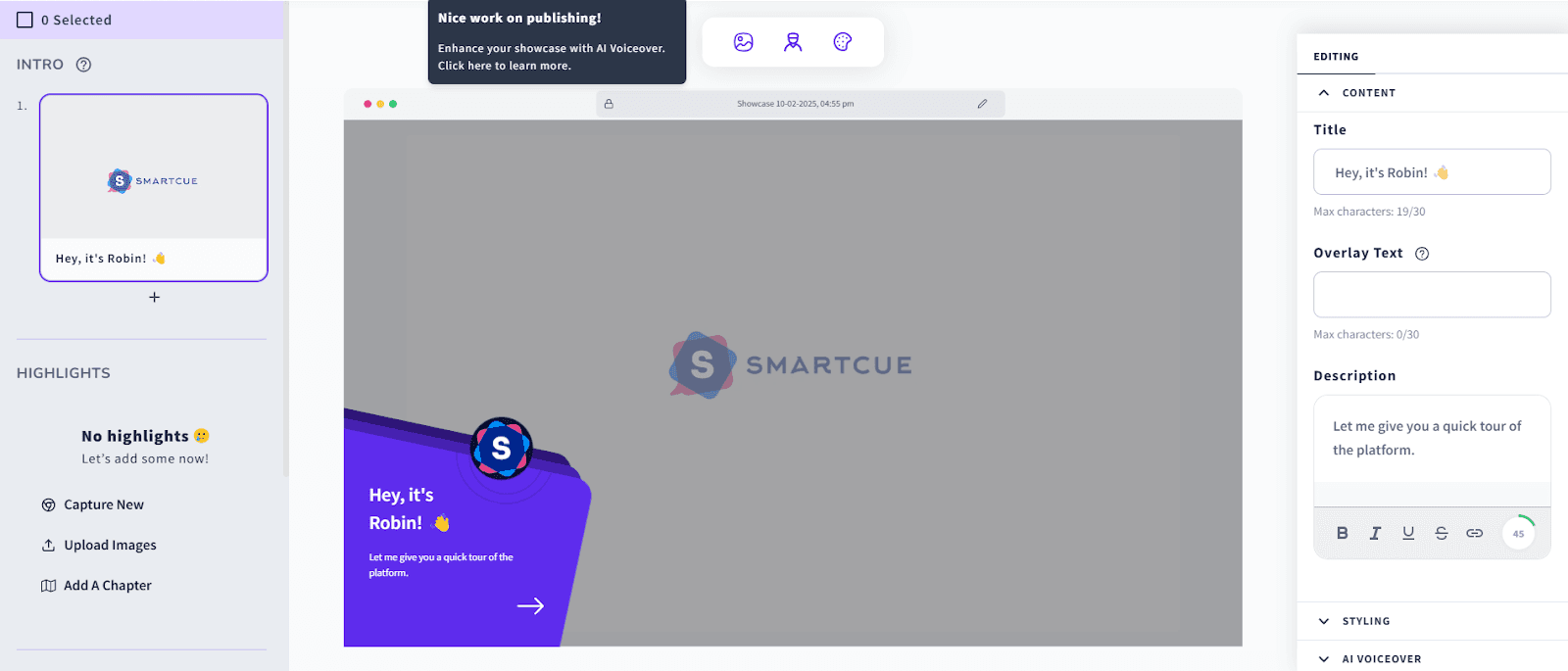
Add text, highlight specific features, and use built-in tools to make your demo engaging and informative.
Step 4: Publish and Share
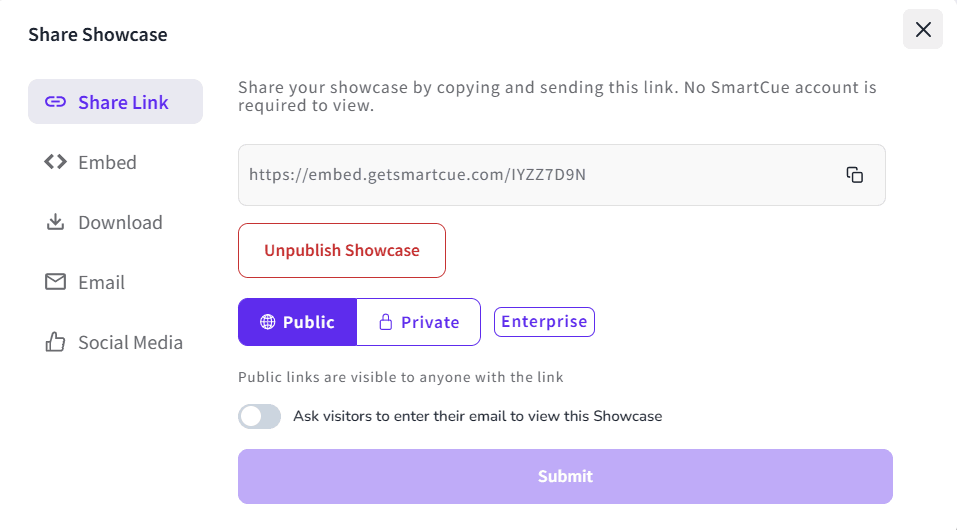
Once you’re happy with the customization, hit Publish to save and share your showcase with prospects.
Ready to see SmartCue in action? Book your live demo now and watch how fast you can turn clicks into customers.
Wrapping It Up
The right demo and interactive software platform should slot into your tech stack without making you rethink everything. For software companies, it’s about creating demo experiences that feel real, not rehearsed, and that show the value of your product faster than any pitch could.
That might mean turning static screenshots into clickable tutorials, using an HTML editor for fine-tuned flows, or setting up demo automation so prospects can explore on their own. Interactive elements and trackable share links make sure every click teaches you something about your buyer, while the best interactive product demo software keeps your demo content working long after the call ends.
Frequently Asked Questions
1. Do personalized interactive demos actually work?
Yes. When your demo speaks directly to a buyer’s role or pain points, it grabs attention fast. Tailored flows help them see your product’s value instantly, which usually means higher engagement, faster decisions, and better conversion rates.
2. What are the different types of interactive product demos?
You’ve got guided tours, clickable demos, sandbox environments, and HTML simulations. Each serves a purpose, from spotlighting a single feature to letting prospects test real workflows, so they can picture exactly how your tool fits their setup.
3. How can I make my demos more engaging?
Add hotspots, tooltips, or branching paths so the experience feels hands-on. Pair that with short, clear walkthroughs and presales context to guide exploration while naturally reinforcing why your product solves their specific problem.
4. What tools help build demos quickly?
Look for platforms with a Chrome extension for instant capture, automation for repetitive flows, and share links with built-in analytics. The best interactive demo software speed up creation, keep branding consistent, and help your team deliver polished demos every time.
5. Can interactive demos be shared beyond sales calls?
Definitely. Drop them into emails, social posts, outbound campaigns, or even your website. Giving prospects self-serve access lets them explore whenever they want, keeping your product top of mind long after the first conversation.


